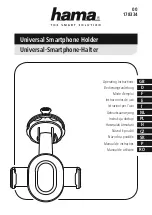
the "Shade Guide Table" below for settings. Turn the shade
control knob on the side of the helmet to the shade number
required.
• SENSITIVITY
The sensitivity can be set to "HI" (high) or "LO" (low) by using
the infinitely dial knob on the back of the shade cartridge. The
"Mid-High" setting is the normal setting for everyday use. The
maximum sensitivity level is appropriate for low welding current
work, TIG, or special applications. Where the operation of the
helmet is disturbed by excess ambient light, or another welding
machine close by, use the "LO" setting. (See fig.3a). As a
simple rule for optimum performance, it is recommended to set
sensitivity to the maximum at the beginning and then gradually
reduce it, until the filter reacts only to the welding light flash and
without annoying spurious triggering due to ambient light
conditions (direct sun, intensive artificial light, neighbouring
welder's arcs etc.).
• SELECTING DELAY TIME
When welding ceases, the viewing window automatically
changes from dark back to light but with a pre-set delay to
compensate for any bright afterglow on the workpiece. The
delay time I response can be set to "S" (short: 0.1 sec.) or "L"
(long: 1.0 sec.). As you require using the infinitely dial knob on
the back of the shade cartridge. (See fig.3b). It is
recommended to use a shorter delay with spot welding
applications and a longer delay with applications using higher
currents. Longer delays can also be used for lower current TIG
welding, and TIG / MIG / MAG pulse.
• SELECTING THE GRIND OPTION
When the shade knob is turned to the "Grind" position, the
shade function is turned off allowing a clear view to grind a
weld with the helmet providing face protection. Before
restarting welding work, ensure that the shade function is
turned back on before welding again (See fig.4).
• ADJUSTING THE FIT OF THE HELMET
The overall circumference of the headgear can be made larger
or smaller by rotating the knob on the back of the headgear
(See ad」ustment "Y" in fig.5). This can be done while wearing
the helmet and allows just the right tension to be set to keep
the helmet firmly on the head without it being too tight.
fig.4
」
曰
\
夸
fig.5
• If the headgear is riding too high or too low on your head, ad」ust the strap which passes
over the top of your head. To do this release the end of the band by pushing the locking pin
out of the hole in the band. Slide the two portions of the band to a greater or lesser width
as required and push the locking pin through the nearest hole. (See adjustment'W in fig.5).
• Test the fit of the headgear by lifting up and dosing down the helmet a few times while
3

























